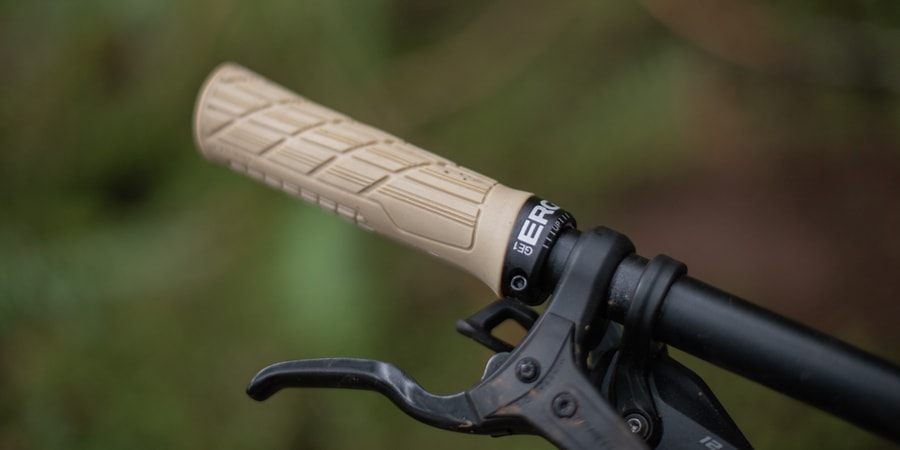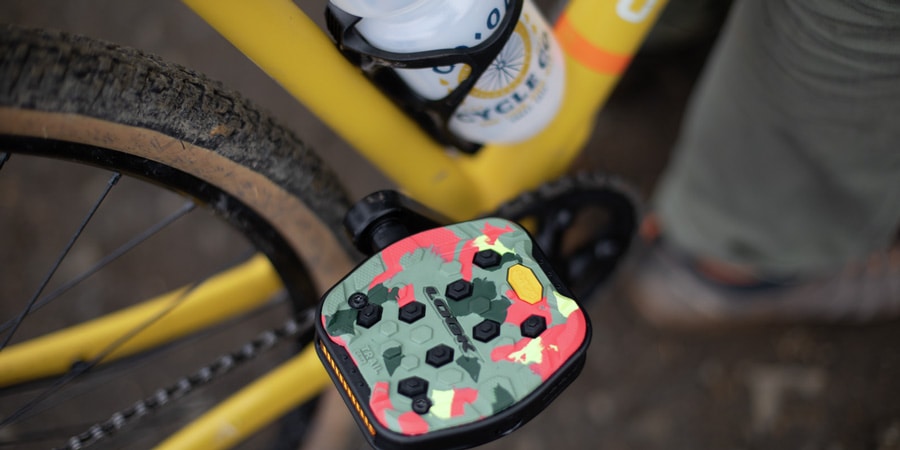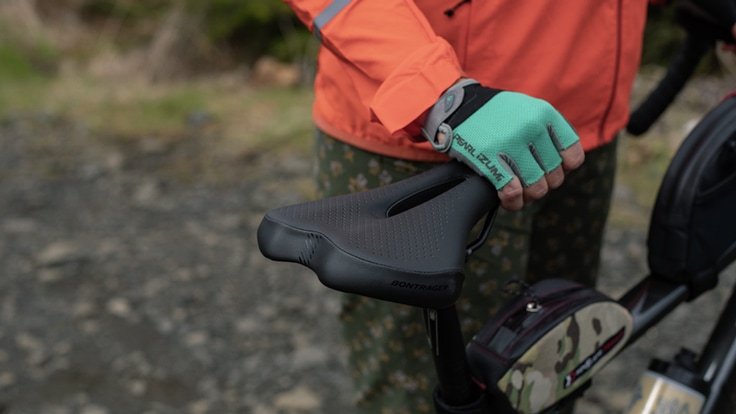Whether you own a brand new or a well-loved mountain bike, road bike or cruiser, upgrading a few key components can rev up your ride. We asked REI bike technicians and two-wheeled aficionados for their advice on the best comfort upgrades (such as your handlebar grips, bar tape, saddle and handlebar) and performance enhancements (such as your pedals, brakes, tires and wheels).
Here are their suggestions, ranging from quick 'n' easy changes you can make right away to larger investments down the road. Read on for the full list of recommendations, or skip ahead to different components.
You can also get personalized advice on these components by visiting your local bike shop. Your bike shop can also install any upgraded components you might choose to buy.
Grips and Bar Tape

Your body touches your bike in three spots—the pedals, seat and handlebars. The last of these spots is arguably the most noticeable point of contact because it's right in front, and you're constantly putting pressure on your hands (and handlebar grips) throughout your ride.
- If you have a flat bar mountain bike or cruiser, swapping out those grips for higher-quality handlebar grips is one affordable way to quickly improve comfort and control. "Upgrading the grips to something softer and squishier, even when you're riding for just an hour, makes a big difference," says Amy Uhlenhopp, a master bike technician at the REI store in Bend, Oregon. "A lot of people tend to grab their bars almost too much, especially if they're new to cycling or they're getting back into it, so it makes a difference to get something softer." Good, comfortable grips can help damp out some of the vibrations from the trail.
- If you have a road bike with a drop bar, then you'll likely want to upgrade the tape that's wrapped around the bar. Bar tape is more than just a flash of color. Like good grips on a flat bar, bar tape helps reduce vibration and cut down on fatigue so you can ride more comfortably for more miles. You can get high quality bar tape for under $50, but applying it can be tricky, so consider having a bike technician install it for you.
Saddle
It's impossible to overstate the importance of the saddle (seat) on your bike. Riding your bike doesn't have to be a pain in the butt. A variety of saddles on the market are designed to accommodate different body types and styles of riding.
First, choose a saddle designed for the type of bike you have and the riding you do. If you're looking for something more comfortable on mountain bike rides, consider a mountain-specific saddle that's padded where your sit-bones hit the seat. If you're looking to save weight on your road bike, choose a long, lean saddle without much padding.
But don't focus entirely on the amount of cushion. "The shape of your body impacts how well the seat is going to work for you," says one staffer at REI's headquarters. "Different shape saddles work for different people." Firmer saddles can actually be more comfortable in the long run. If you're cycling regularly, your body adapts to that firm saddle and your movements are more efficient because you're not hindered by thick layers of foam.
Learn more by reading How to Choose a Bike Seat.
Handlebars
Of all the components on your bicycle, the handlebar might be the easiest to overlook. The bar that comes with your bike is not the only option, and switching to a different handlebar can often have a measurable effect on your bike's handling and your comfort in the cockpit.
Consider the following drop bar and flat bar variations for your bike:
- Mountain bikes and hybrid bikes usually have flat bars and riser bars that put you more upright in the cockpit. Wider bars can offer more stable handling on mountain bikes, but you don't want to go too wide. Ideally, look for a handlebar that is the same width as your shoulders. Meanwhile, switching to a flat bar with rise will put you more upright in the cockpit, giving you a less aggressive, more relaxed riding position.
- Road bikes typically have a drop bar, which allows you to put your hands in multiple positions, raising or lowering the angle of your torso in the process. Drop bars have seen some technological advances in recent years in both material (hello carbon fiber, which can be 40% lighter than aluminum) and shape, with flat sections in the center of the bar designed to give your hands an ideal resting position. You can also find a drop bar with a dramatic flair near the ends of the bar, giving you a wider, more stable handling position.
As with saddles, the bar you choose depends largely on the style of riding you want to do and the personal fit with your body.
Learn more by reading How to Choose Bike Handlebars.
Pedals

Your pedal transfers power from your leg to your bike, making the pedal an especially important point of contact. Many bikes come straight from the sales floor without pedals or come with pedals that could stand an upgrade.
"The right pedal set matched to the riding style will increase proper pedaling efficiency, ride feel, and some provide footwear versatility," says Larisa Castile, a retail specialist in the REI San Diego store.
Your first decision when choosing pedals is whether you want to ride clipless (meaning your shoes must have cleats that clip into the pedals) or in flats (meaning your pedals don't require you to wear special bike shoes that clip into them).
Flats (platform) pedals: Recreational cyclists who don't want to wear bike shoes with cleats, which are not as comfortable to walk in, can choose a flat (platform) pedal. If you're just cruising around town and riding for general fitness, stick with flats, which are less intimidating. For well under $100, you can find many lightweight flats that will work with your favorite pair of tennies.
Flats are also prevalent in mountain biking. Mountain bike flats have pins that serve to grip the soles of mountain bike specific shoes, thus providing tight contact between your feet and the pedals.
Clipless pedals: If you take your road cycling more seriously, clipless pedals are practically mandatory. Going clipless will give you more control over the bike (bunny hopping is a piece of cake). Clipless pedals also allow you to both pull up and push down on the pedals, boosting power transfer and pedaling efficiency. Clipless pedal categories vary, but three-hole and SPD are the most common. Ultimately, the choice comes down to personal preference. Also, if your road bike pulls double duty as an around-town cruiser, consider a dual-sided pedal that pulls double duty, too, with one side made for flats and the other compatible with cleats.
Learn more by reading How to Choose Bike Pedals and How to Choose Bike Shoes.
Brakes
Cyclists spend a lot of effort trying to make their bikes lighter and faster, but spending a little money on added stopping power might be a smarter upgrade. Not only are better brakes more responsive, they can also help make you faster.
"Upgrading the brakes on your road bike will fundamentally change the way you ride your bike," says Tim Burdelski, a certified technician at REI's Rockville, Maryland, store. "Hill descents will become faster, cornering will become faster and anxiety about being near cars will decrease, all because you'll know that your bike will stop powerfully and consistently."
The least expensive and quickest way to breathe new life into your brakes is to replace the brake pads—the tiny squares of rubber that actually squeeze the rotors or rims to slow and stop your bike. Most bikes made within the last decade use disc brakes, but the disc systems still use pads that wear out over time and will need to be replaced. New pads will help give you more stopping power.
If your bike is more than a few years old, you might consider replacing the entire braking system, as there have been some marked improvements in disc brake technology in the last few years. Brakes are lighter and more efficient than older versions thanks to in-line hydraulic reservoirs. Hydraulic disc brakes are much more responsive and offer better modulation (variations between all-on or all-off) than mechanical disc brakes. They're powerful enough to be operated by just your index finger, allowing you to keep more of your hand on the grip and hence have better control of your bike.
Tires
Tires are the bike's only contact with the ground. So you want to make sure you have the best contact possible, whether you're riding on pavement or sandy desert trails. If you've been riding the same tires for several years, it may be time to make a switch. If your bike came with base level tires, upgrading the tires can give you less rolling resistance, reduce rotational weight and improve your overall speed and feel. Fortunately, tires are one of the least expensive upgrades you can make, and often the easiest to install. (Switching tires is the same process as fixing a flat tire).
"Get a tire that's appropriate for where you're riding," says Uhlenhopp, the master bike technician in REI's Bend, Oregon, store. Look for the type of tread that matches the riding you do most often. For mountain bikes, tires with wider-spaced knobs handle better in loose and wet terrain. For road bikes, choose from tires with little to no tread, called slicks, which are meant for pavement only, to wider, knobbier tires built for mixed terrain rides.
A lot of cyclists are opting for wider tires on both road bikes and mountain bikes for better traction as well as a more comfortable ride. (Sure, thinner tires are more efficient, but a 28 mm road tire inflated to 100 psi can be significantly more comfortable than a 23 mm tire at the same pressure.) Also, the popularity of gravel riding has resulted in roadies looking for a wider tire to help cushion some of that chatter when the pavement gives way to gravel.
Match the size of the tire to the size of your wheel and be sure to check your frame clearance to figure out how wide of a tire you can run. Keep in mind, too, that wider tires tend to be heavier, so there's a tradeoff between speed and traction.
Learn more by reading How to Choose Bike Tires.
Wheels
Buying a new set of bike wheels could be the most expensive upgrade you make but doing so could make the most impact on the performance of your old ride.
"Upgraded wheels are going to be lighter and more durable," says Nolan Jankowski, a certified bike technician at REI in San Diego. "Oftentimes they have better bearing sets so they're more energy efficient and they roll easier and faster."
Prices for wheel sets have a vast range, from $45 to $2,000. If you're looking to increase your performance, look to carbon fiber, which will be more expensive but are lighter than traditional aluminum and also have better lateral stiffness, which results in wheels that remain truer over time. Lighter, stiffer wheels will make an immediate impact on the performance of your bike, saving you a pound or two in overall bike weight while making your pedaling more energy efficient in the process. The result is a faster, livelier ride.
Learn more by reading How to Choose Bike Wheels.

